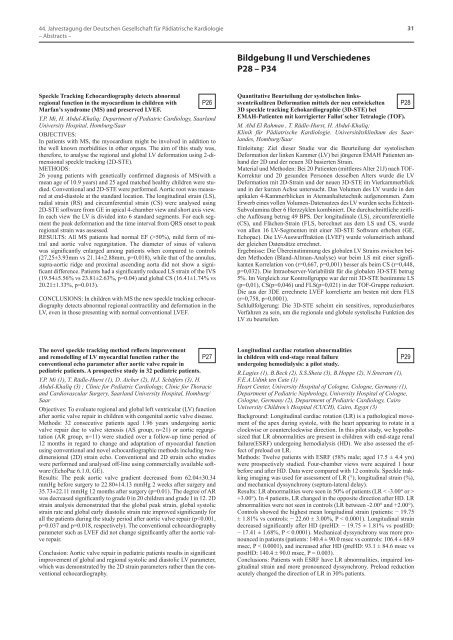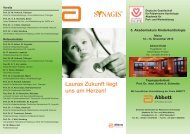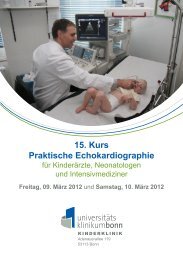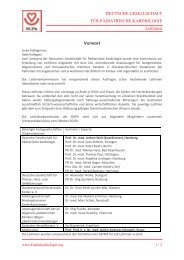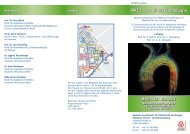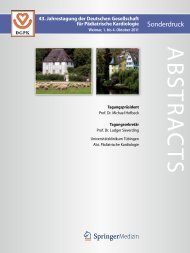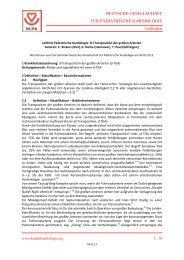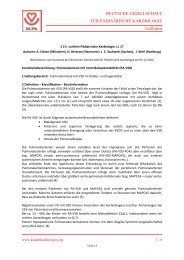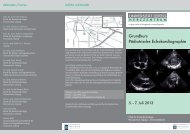Abstraktband als pdf - DGPK-Deutsche Gesellschaft für Pädiatrische ...
Abstraktband als pdf - DGPK-Deutsche Gesellschaft für Pädiatrische ...
Abstraktband als pdf - DGPK-Deutsche Gesellschaft für Pädiatrische ...
Sie wollen auch ein ePaper? Erhöhen Sie die Reichweite Ihrer Titel.
YUMPU macht aus Druck-PDFs automatisch weboptimierte ePaper, die Google liebt.
44. Jahrestagung der <strong>Deutsche</strong>n <strong>Gesellschaft</strong> für Pädiatrische Kardiologie<br />
– Abstracts –<br />
31<br />
Bildgebung II und Verschiedenes<br />
P28 – P34<br />
Speckle Tracking Echocardiography detects abnormal<br />
regional function in the myocardium in children with P26<br />
Marfan’s syndrome (MS) and preserved LVEF.<br />
Y.P. Mi, H. Abdul-Khaliq; Department of Pediatric Cardiology, Saarland<br />
University Hospital, Homburg/Saar<br />
OBJECTIVES:<br />
In patients with MS, the myocardium might be involved in addition to<br />
the well known morbidities in other organs. The aim of this study was,<br />
therefore, to analyse the regional and global LV deformation using 2-dimensional<br />
speckle tracking (2D-STE).<br />
METHODS:<br />
26 young patients with genetically confirmed diagnosis of MS(with a<br />
mean age of 10.9 years) and 25 aged matched healthy children were studied.<br />
Conventional and 2D-STE were performed. Aortic root was measured<br />
at end-diastole at the standard location. The longitudinal strain (LS),<br />
radial strain (RS) and circumferential strain (CS) were analysed using<br />
2D-STE software from GE in apical 4-chamber view and short axis view.<br />
In each view the LV is divided into 6 standard segments. For each segment<br />
the peak deformation and the time interval from QRS onset to peak<br />
regional strain was assessed.<br />
RESULTS: All MS patients had normal EF (>50%), mild form of mitral<br />
and aortic valve regurgitation. The diameter of sinus of v<strong>als</strong>ava<br />
was significantly enlarged among patients when compared to controls<br />
(27.25±3.93mm vs 21.14±2.88mm, p=0.018), while that of the annulus,<br />
supra-aortic ridge and proximal ascending aorta did not show a significant<br />
difference. Patients had a significantly reduced LS strain of the IVS<br />
(19.54±5.56% vs 23.81±2.63%, p=0.04) and global CS (16.41±1.74% vs<br />
20.21±1.33%, p=0.013).<br />
CONCLUSIONS: In children with MS the new speckle tracking echocardiography<br />
detects abnormal regional contractility and deformation in the<br />
LV, even in those presenting with normal conventional LVEF.<br />
Quantitative Beurteilung der systolischen linkssventrikulären<br />
Deformation mittels der neu entwickelten P28<br />
3D speckle tracking Echokardiographie (3D-STE) bei<br />
EMAH-Patienten mit korrigierter Fallot`scher Tetralogie (TOF).<br />
M. Abd El Rahman , T. Rädle-Hurst, H. Abdul-Khaliq;<br />
Klinik für Pädiatrische Kardiologie. Universitätsklinikum des Saarlandes,<br />
Homburg/Saar<br />
Einleitung: Ziel dieser Studie war die Beurteilung der systolischen<br />
Deformation der linken Kammer (LV) bei jüngeren EMAH Patienten anhand<br />
der 2D und der neuen 3D basierten Strain.<br />
Material und Methoden: Bei 20 Patienten (mittleres Alter 21J) nach TOF-<br />
Korrektur und 20 gesunden Personen desselben Alters wurde die LV<br />
Deformation mit 2D-Strain und der neuen 3D-STE im Vierkammerblick<br />
und in der kurzen Achse untersucht. Das Volumen des LV wurde in den<br />
apikalen 4-Kammerblicken in Atemanhaltetechnik aufgenommen. Zum<br />
Erwerb eines vollen Volumen-Datensatzes des LV wurden sechs Echtzeit-<br />
Subvolumina über 6 Herzzyklen kombiniert. Die durchschnittliche zeitliche<br />
Auflösung betrug 49 BPS. Der longitudinale (LS), zircumferentielle<br />
(CS), und Flächen-Strain (FLS, berechnet aus dem LS und CS, wurde<br />
von allen 16 LV-Segmenten mit einer 3D-STE Software erhoben (GE,<br />
Echopac). Die LV-Auswurffraktion (LVEF) wurde volumetrisch anhand<br />
der gleichen Datensätze errechnet.<br />
Ergebnisse: Die Übereinstimmung des globalen LV Strains zwischen beiden<br />
Methoden (Bland-Altman-Analyse) war beim LS mit einer signifikanten<br />
Korrelation von (r=0,667, p=0,001) besser <strong>als</strong> beim CS (r=0,448,<br />
p=0,032). Die Intraobserver-Variabilität für die globalen 3D-STE betrug<br />
5%. Im Vergleich zur Kontrollgruppe war der mit 3D-STE bestimmte LS<br />
(p=0,01), CS(p=0,046) und FLS(p=0,021) in der TOF-Gruppe reduziert.<br />
Die aus der 3DE errechnete LVEF korrelierte am besten mit dem FLS<br />
(r=0,758, p=0,0001).<br />
Schlußfolgerung: Die 3D-STE scheint ein sensitives, reproduzierbares<br />
Verfahren zu sein, um die regionale und globale systolische Funktion des<br />
LV zu beurteilen.<br />
The novel speckle tracking method reflects improvement<br />
and remodelling of LV myocardial function rather the P27<br />
conventional echo parameter after aortic valve repair in<br />
pediatric patients. A prospective study in 32 pediatric patients.<br />
Y.P. Mi (1), T. Rädle-Hurst (1), D. Aicher (2), H.J. Schäfers (3), H.<br />
Abdul-Khaliq (3) ; Clinic for Pediatric Cardiology, Clinic for Thoracic<br />
and Cardiovascular Surgery, Saarland University Hospital, Homburg/<br />
Saar<br />
Objectives: To evaluate regional and global left ventricular (LV) function<br />
after aortic valve repair in children with congenital aortic valve disease.<br />
Methods: 32 consecutive patients aged 1.96 years undergoing aortic<br />
valve repair due to valve stenosis (AS group, n=21) or aortic regurgitation<br />
(AR group, n=11) were studied over a follow-up time period of<br />
12 months in regard to change and adaptation of myocardial function<br />
using conventional and novel echocardiographic methods including twodimensional<br />
(2D) strain echo. Conventional and 2D strain echo studies<br />
were performed and analysed off-line using commercially available software<br />
(EchoPac 6.1.0, GE).<br />
Results: The peak aortic valve gradient decreased from 62.04±30.34<br />
mmHg before surgery to 22.80±14.13 mmHg 2 weeks after surgery and<br />
35.73±22.11 mmHg 12 months after surgery (p=0.01). The degree of AR<br />
was decreased significantly to grade 0 in 20 children and grade I in 12. 2D<br />
strain analysis demonstrated that the global peak strain, global systolic<br />
strain rate and global early diastolic strain rate improved significantly for<br />
all the patients during the study period after aortic valve repair (p<br />
+3.00°). In 4 patients, LR changed in the opposite direction after HD. LR<br />
abnormalities were not seen in controls (LR between -2.00° and +2.00°).<br />
Controls showed the highest mean longitudinal strain (patients: − 19.75<br />
± 1.81% vs controls: − 22.60 ± 3.00%, P < 0.0001). Longitudinal strain<br />
decreased significantly after HD (preHD: − 19.75 ± 1.81% vs postHD:<br />
− 17.41 ± 1.68%, P < 0.0001). Mechanical dyssynchrony was more pronounced<br />
in patients (patients: 140.4 ± 90.0 msec vs controls: 106.4 ± 68.9<br />
msec, P < 0.0001), and increased after HD (preHD: 93.1 ± 84.6 msec vs<br />
postHD: 140.4 ± 90.0 msec, P = 0.003).<br />
Conclusions: Patients with ESRF have LR abnormalities, impaired longitudinal<br />
strain and more pronounced dyssynchrony. Preload reduction<br />
acutely changed the direction of LR in 30% patients.


